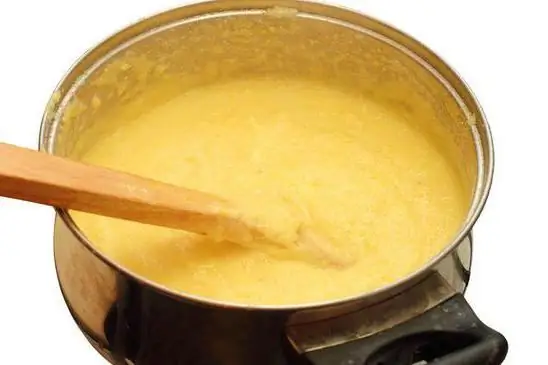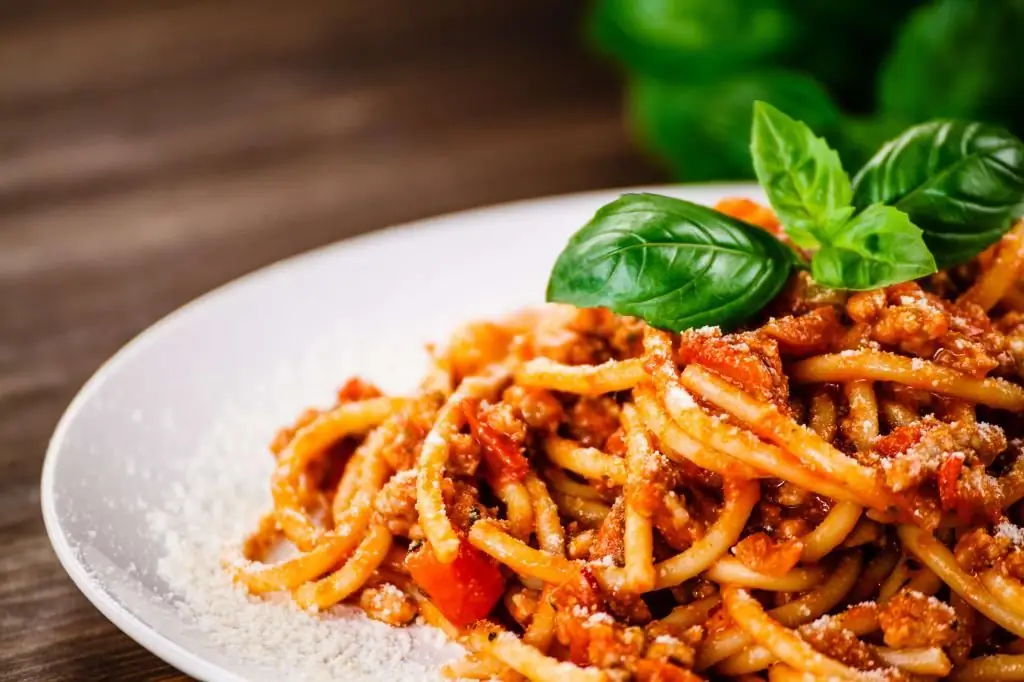2025 Author: Isabella Gilson | [email protected]. Last modified: 2025-01-23 12:50:39
A business card and pride of Caucasian cuisine, Abkhaz adjika has a recognizable spicy taste, does not contain any chemical additives and preservatives. It contains only natural ingredients: hot pepper, s alt, spices. Adjika is used in the preparation of many dishes as a fragrant and spicy additive. It goes well with fish, meat, pastries. It is added to sauces, soups, ketchups and mayonnaise.
It is best to buy this seasoning in the Caucasus, where it is made according to ancient family recipes. However, not everyone has such an opportunity, and good adjika is eaten very quickly. In Russian stores you can see jars with the inscription: "Abkhaz adjika Amts". But in what conditions and according to what recipe this product is made, it is difficult to say. In order not to get into trouble, it's easier to learn how to do the right adjika once and no longer depend on circumstances.

History
According to a beautiful legend, the Abkhaz adjika recipe appeared thanks tothe ingenuity of the shepherds. When they took the flocks to the mountain pastures, they were given s alt, which had to be fed to the sheep so that the animals would eat more, drink more and gain weight. S alt was a very valuable product, and in order to prevent theft, they began to add hot pepper to it.
But the effect was the opposite. Shepherds mixed hot s alt with fragrant spices, and then rubbed the mixture between two flat stones. The resulting seasoning began to be added to food and was called adzhiktsattsa, which in translation from the Abkhaz means “s alt ground with something.”
The real adjika
The new seasoning turned out to be so tasty and versatile in use that it has firmly entered the Caucasian cuisine. The flat stones used by the shepherds were replaced by special stones: a massive rectangular one with a recess where the adjika components were placed, and a small oblong stone - they were used to grind the ingredients.
Generations have followed each other in a row, and the seasoning recipe has not changed much. In different families, the ratio of products could vary, but the composition of the Abkhaz adjika remained the same: hot pepper, garlic, coarse s alt, blue fenugreek and coriander seeds. All! No tomatoes, eggplant, zucchini or bell peppers. The additionally added spices were a personal initiative of each individual housewife and an actual deviation from the reference recipe.
Until now, despite the appearance of kitchen appliances, in the Caucasian villages, women cook the classic Abkhaz adjika using traditional stones. They believe that measured grinding between stonesmost effectively releases and mixes the essential oils rich in ingredients. The grated seasoning is not chopped, but similar to butter, delicate in texture, unimaginably fragrant, and most importantly, tasty and he althy. No wonder Caucasians call adjika a cure for a thousand diseases.

Cooking principles
Of course, in the cities of Russia it makes no sense to look for special stones for making Abkhazian adjika. It is enough to have a meat grinder or a powerful blender. Those who want to make the seasoning as close as possible to the classic version can use a stone mortar, but remember that remarkable efforts and perseverance will be required.
The principles of cooking adjika are simple:
- correctly selected products;
- their proper preparation;
- careful grinding of ingredients.
Hot pepper determines the spiciness. Therefore, do not be shy to try it when buying. From not very hot pepper you get the same adjika. Coriander seeds and dry fenugreek are best bought from trusted sellers. You should not take already ground seeds, they have practically no essential oils that give the seasoning flavor. S alt should be coarse and without iodine.
Peppers should be dry. Its seeds and internal partitions are very pungent. To leave them or not is an individual choice. However, they are left in real Abkhazian adjika so that the final product is sharper.

To achieve at least approximately the sameoily consistency that real adjika has, its constituent products must be passed through a meat grinder several times or ground very carefully with a blender. Moreover, s alt is added at the very beginning so that it becomes an additional abrasive material, rubbing other components.
Tips
Here are some tips that will come in handy in the process of making adjika:
- If it was not possible to find blue fenugreek, you can use suneli hops instead in seasoning.
- Pepper pods must be dry. They can be air dried, but not in direct sunlight. And you can dry it in a pan or in a slightly heated oven. So the pods will not only dry out, but also acquire an original smoky aroma. The main thing is not to overdo it with heat treatment.
- S alt is the most important component of adjika. It is involved in grinding the ingredients and allows the seasoning to be stored for a long time. The more s alt, the longer the shelf life.
- Adjika is best laid out in glass containers. The plastic can transfer its smell to the product and the bags are not very reliable.
Safety
Precautions to be taken while cooking:
- The burning components of adjika are dangerous for the skin of the hands. Therefore, you need to prepare the seasoning in disposable cellophane or rubber gloves. At the same time, making sure not to accidentally touch your face or eyes with your fingers - the consequences can be very sad.
- When working with pepper and garlic, it is better not to let children into the kitchen. They are very curious and redPepper looks very tempting and can harm the baby if it is in his hands or in his mouth.
- With ready-made Abkhaz adjika, you also need to be careful. Eat in moderation so as not to burn the tongue or the walls of the stomach. It is wise to add to food, because even the most delicious dish can be made inedible if you overdo it with hot seasoning.

Recipe for classic Abkhaz adjika
Ingredients:
- hot pepper - 500 grams;
- blue fenugreek and coriander seeds - 15 grams each (or to taste);
- garlic - 50 grams;
- s alt - 100 grams.

Rinse the pepper and put it to dry for three days in a ventilated place, but not in the sun. After that, wash the pods again, dry, remove the stalks and cut into pieces. If you want to make adjika moderately spicy, then the seeds and white partitions must be removed. Mix all the ingredients and grind with a blender, in a stone mortar or pass several times through a meat grinder using a nozzle with a minimum hole diameter. Arrange in glass jars, refrigerate or dark place.
Green adjika
Ingredients:
- green hot pepper - 500 grams;
- dill, green cilantro, parsley - in a large bunch;
- garlic - three large heads;
- walnuts - 150 grams;
- blue fenugreek and coriander seeds - 15 grams each (or to taste) or three to four tablespoons of suneli hops;
- a glass of cookings alt.

Adjika turns out to be very spicy, rich green and moderately spicy. Dry and cut the pepper in the same way as in the classic recipe. Then mix the ingredients and pass through a meat grinder until a homogeneous oily mass is obtained. Arrange adjika in glass jars and refrigerate.
Dry Abkhaz adjika
Ingredients:
- ground red pepper or dry hot pepper pods - 30 grams;
- seeds of blue fenugreek, dill, coriander, savory and basil - 50 grams each;
- s alt to taste.
Dry adjika is an excellent seasoning that can be added during cooking or to ready-made dishes. The interweaving of aromas of several spices gives the food a special savory note, characteristic of Caucasian cuisine. This adjika is easy to prepare and keeps for a long time. All ingredients must be mixed and thoroughly crushed in a mortar. Then sprinkle in glass jars or special containers for bulk seasonings.
Recommended:
The best national dish of Abkhazia. Traditions of Abkhaz cuisine. National dishes of Abkhazia: recipes

Every country and culture is famous for its cuisine. This applies to Russia, Ukraine, Italy, etc. In this article, you will read about several main national dishes of Abkhazia. You will learn how they are prepared and what are some cooking secrets
Bolognese recipe: classic step by step recipe with photo

Bolognese is a traditional Italian sauce made from vegetables and minced meat. The dish turns out hearty, fragrant and rich. As a rule, it is served with pasta or spaghetti. This article contains recipes for the classic bolognese. Step-by-step recipes will help you please your loved ones with a new delicious dish
Recipe for pork and beef cutlets. Classic cutlets: a step by step recipe

Cutlets are the greatest work of culinary art. It can be said that the acquaintance of a small person with meat dishes begins with them. They are also good because you can fry them a little more on the weekends - and for several days you don’t have to worry that, having come from work, you have to stand at the stove in order to feed a hungry family. In this article, we will reveal the intricacies of preparing this wonderful dish and suggest some interesting variations of it
Abkhaz adjika. Recipe

For the preparation of many dishes, marinades, sauces, and also as a separate seasoning, the peoples of the Caucasus widely use a spicy and fragrant pasty mass of red or green pepper, garlic, herbs and s alt - Abkhazian adjika. Its recipe varies depending on the area
Abkhaz cuisine: features and recipes

Abkhazian cuisine is very original and different from the "general Caucasian". The article will discuss its features, several recipes will be offered

